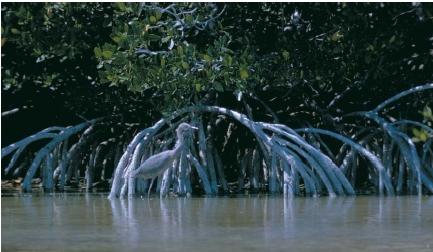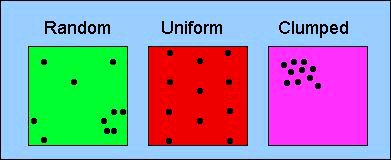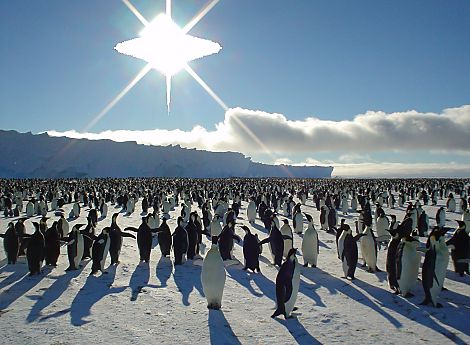
6. Taigas are characterized by coniferous forests (pines, firs, and other trees with needles for leaves). Winters are cold, precipitation is in the form of snow.
7. Tundras are subject to winters so cold that the ground freezes. During the summers, the upper topsoil thaws, but the deeper soil, the permafrost, remains permanently frozen. During the summer, the melted topsoil supports a grassland type community consisting of grasses, sedges, and other vegetation tolerant of soggy soils.


8. Freshwater biomes include ponds, lakes, streams and

rivers.
9. Marine biomes include estuaries (where oc
eans meet rivers), intertidal zones (where oceans meet land), continental shelves ( the relatively shallow oceans that border continents), coral reefs (masses of corals that reach the ocean surface), and the pelagic ocean (the deep oceans).
Biological magnification is when one organism eats another, the toxin becomes more and more concentrated.
Algal blooms are massive growths of algae and other phytoplankton that are stimulated from abundant nutrients caused by runoff fertilizers or sewage.
Eutophication is the process of nutrient enrichment in lakes and the subsequent increase in biomass.
(Example of Biological Magnification )
"They paved paradise and put up a parking lot... Hey farmer, farmer, put away your DDT... Leave me the birds and the bees." ~Counting Crows

Chapter 53 Population Ecology
Population ecology is the study of the growth, abundance, and distribution of populations. Population ecology explores how biotic and abiotic factors influence the density, size, and age structure of populations. Population abundance and distribution are described by the following terms:
1. The size of a populations, symbolically represented by N, is the total number of individuals in the populations.
2. The density of a population is the total number of individuals per area of volume occupied
- ecologists also use the mark-recapture method to estimate the size of wildlife populations
3. Dispersion describes how individuals in a population are distributed. They may be clumped, uniform, or random.

These penguins are an example of a uniform pattern of dispersion

4. Age structure is a description of the abundance of individuals of each age. It is often graphically expressed in an age structure diagram.
5. Survivorship curves describe how mortality of individuals in a species varies during their lifetimes.
Type I: describes species in which most individuals survive to middle age, ex: humans
Type II: describes organisms in which the length of survivorship is random, ex: rodents hydra, squirrels
Type III: describes species in which most individuals young, ex: oysters

Demography is the study of the vital statistics of populations and how they change over time. Populations increase from births and immigration and decrease from deaths and emigration.
The following all summarize specific demographic trends:
Life tables are age-specific summaries of the survival pattern of a population (A cohort is a group of individuals of the same age).
Survivorship curves
Reproductive tables or fertility schedules, which are age-specific summaries of the reproductive rates in a population.
Life history traits are products are products of natural selection
Life history entails three basic variables: when reproduction begins, how often the organism reproduces, and how many offspring are produced during each reproductive episode.
-Life history history traits are evolutionary outcomes reflected in the department,
physiology and behavior of an organism
Big-bang, or semelparous organisms reproduce once and die.
Iteroparous organisms produce offspring repeatedly
The following terms are used to describe population growth:
1. The biotic potential is the maximum growth rate of a population under ideal conditions, with unlimited resources and without any growth restrictions.
age of reproductive maturity
clutch size
frequency of reproduction
reproductive lifetime
survivorship of offspring to reproductive maturity
2. The carrying capacity is the maximum number of individuals of a population that can be sustained by a particular habitat.
3. Limiting factors are those elements that prevent a population from attaining its biotic potential. Limiting factors are categorized into density-dependent and density- independent factors, as follows:
Density dependent factors are those agents, whose limiting effect becomes more intense as the population density increases.
parasites
disease
competition for resources
toxic effect of waste products
predation
Density independent factors occur independently of the density of the population
natural disasters
extremes of climate
The exponential model describes population growth in an idealized, unlimited environment
The growth of a population can be described by the following equation:
r= (births-deaths)/N
r is the productive rate (or growth rate)
N is the population size at beginning of interval for which the births and deaths are counted
The numerators of the equation is the net increase in individuals
Example: In this equation, a population of size N=1000 had 60 births and 10 deaths over a
one year period, then r would equal
(60-10)/1000= 0.05 per year

If both sides of the equation are multiplied by N, the equation can be expressed as follows:
Delta N/ Delta T= rN= births-deaths
The Greek Letter delta (equilateral triangle) means "change in," Thus Delta N/ Delta t means the
change in the number of individuals in a given time interval.
When the reproductive rate, r is the maximum (the biotic potential) it is called the
intrinsic rate of growth. Note, however, that when deaths exceed births, r will be negative,
and the population size will decrease. On the other hand, when births and deaths are equal,
the growth rate is zero and the population size remains constant (ZPG).
Multiple-Choice Questions
1. Which of the following is not included in density dependent factors?
a. predation
b. natural disaster
c. disease
d. competition for resources
2. Population abundance and distribution are described by all but which of the follwing?
a. dispersion
b. density
c. age structure
d. reproductive lifetime
3. The biotic potential includes all but which of the following?
a. frequency of reproduction
b. age of reproductive maturity
c. age structure
d. clutch size
Answers: 1. b, 2. d, 3.c
No comments:
Post a Comment